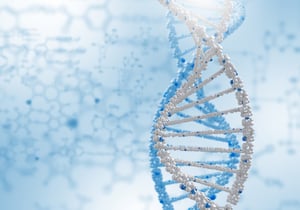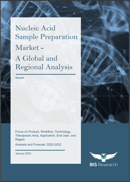 Nucleic acid sample preparation is a crucial part of molecular biology research as it lays the foundation for downstream molecular biology applications. The quality and quantity of the purified DNA or RNA obtained from the biological sample determine the success of subsequent experiments.
Nucleic acid sample preparation is a crucial part of molecular biology research as it lays the foundation for downstream molecular biology applications. The quality and quantity of the purified DNA or RNA obtained from the biological sample determine the success of subsequent experiments.
In this blog, we will explain how the advancements in nucleic acid sample preparation technology have revolutionized molecular biology research by providing researchers with more efficient, accurate, and cost-effective methods for purifying and preparing nucleic acids from biological samples.
The Importance of Nucleic Acid Sample Preparation
The quality of the purified nucleic acids obtained from the biological sample directly impacts the success of downstream molecular biology applications such as polymerase chain reaction (PCR), sequencing, and gene expression analysis. Contaminants such as salts, proteins, and other organic compounds can interfere with the subsequent experiments, leading to inaccurate results. In addition, nucleic acids are susceptible to degradation, leading to reduced yield and quality. Thus, proper nucleic acid sample preparation is crucial in ensuring that the downstream experiments are performed optimally.
Advancements in Nucleic Acid Sample Preparation Technology
The field of nucleic acid sample preparation has seen significant advancements. This growth can be attributed to increased demand for downstream applications such as next-generation sequencing (NGS) and others, and the advancement in nucleic acid extraction/isolation techniques has driven significant growth of the nucleic acid sample preparation market.
According to the BIS Research analysis, the global nucleic acid sample preparation market is projected to reach $11.20 billion by 2032 from $4.21 billion in 2022, growing at a CAGR of 10.27% during the forecast period 2022-2032.
These advancements have led to the development of more efficient, accurate, and cost-effective methods for purifying and preparing nucleic acids from biological samples. Some of the innovations in nucleic acid sample preparation technology are discussed below.
- Automation: The advent of automated nucleic acid sample preparation has revolutionized the field of molecular biology research. Automated nucleic acid sample preparation systems provide researchers with a faster, more consistent, and more reliable method for purifying nucleic acids from biological samples. These systems use robotic arms to perform the various steps of the sample preparation process, reducing the risk of human error and variability. In addition, automated systems can handle a large number of samples simultaneously, making them ideal for high-throughput applications.
- Improved Nucleic Acid Extraction Methods: Nucleic acid extraction is the first step in the nucleic acid sample preparation process. Advances in nucleic acid extraction technology have led to the development of more efficient and accurate methods for purifying nucleic acids from biological samples. For example, bead-based extraction methods provide researchers with a fast and efficient method for purifying nucleic acids from a wide range of sample types. In addition, magnetic bead-based extraction methods have been developed that allow for the purification of nucleic acids in a magnetic field, reducing the risk of contamination and improving the purity of the purified nucleic acids.
- New Lysis Techniques: Lysis is the process of breaking open the cells in the biological sample to release nucleic acids. Advances in lysis technology have led to the development of new lysis techniques that provide researchers with a more efficient and reliable method for releasing nucleic acids from cells. For example, sonication-based lysis techniques provide researchers with a fast and efficient method for breaking open cells, while homogenization-based lysis techniques provide researchers with a gentle and efficient method for breaking open cells without damaging the nucleic acids.
- Quality Control Tools: Quality control is a crucial aspect of nucleic acid sample preparation as it ensures that the purified nucleic acids are of high quality and suitable for downstream molecular biology applications. Advances in nucleic acid sample preparation technology have led to the development of new quality control tools that provide researchers with a more efficient and accurate method for verifying the quality and purity of the purified nucleic acids.
For instance, spectrophotometry-based quality control tools provide researchers with a fast and accurate method for quantifying the amount of nucleic acids present in the purified sample, while gel elect phoresis-based quality control tools provide researchers with a visual representation of the size and quality of the purified nucleic acids. These quality control tools play a crucial role in ensuring the success of downstream molecular biology applications and, ultimately, the accuracy of the results.
Conclusion
The advancements in nucleic acid sample preparation technology have had a profound impact on molecular biology research. The development of more efficient, accurate, and cost-effective methods for purifying and preparing nucleic acids from biological samples has greatly facilitated the research process and has opened new avenues for scientific exploration. The automation of nucleic acid sample preparation, improved nucleic acid extraction methods, new lysis techniques, and quality control tools have all contributed to the advancement of this field and will continue to drive innovation in molecular biology research.
In the future, we can expect to see continued advancements in nucleic acid sample preparation technology, leading to even more efficient and reliable methods for purifying and preparing nucleic acids from biological samples. This will pave the way for even more exciting discoveries in the field of molecular biology and further our understanding of the complex processes that underlie life.
Learn More
 For more information on this fast-growing market, please see Nucleic Acid Sample Preparation Market - Analysis and Forecast, 2022-2032, a detailed report packed with data and insights covering market segmentation, recent market developments, market demand, drivers and challenges, the competitive landscape, and key players. This report draws on extensive primary and secondary research to help industry players design the right business strategies for this competitive, ever-shifting market.
For more information on this fast-growing market, please see Nucleic Acid Sample Preparation Market - Analysis and Forecast, 2022-2032, a detailed report packed with data and insights covering market segmentation, recent market developments, market demand, drivers and challenges, the competitive landscape, and key players. This report draws on extensive primary and secondary research to help industry players design the right business strategies for this competitive, ever-shifting market.
About the Publisher: BIS Research is a global market intelligence, research and advisory company that focuses on emerging technology trends that are likely to disrupt the market. Its team includes industry veterans, experts, and analysts with diverse backgrounds in consulting, investment banking, government, and academia.

